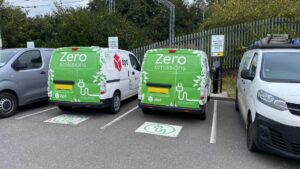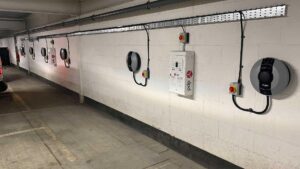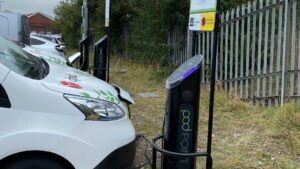DPD: Case Study
Parcel firm cleans up the last mile with EV chargepoint rollout.
Last updated: Aug 29, 2023 • 7 min read

Highlights
Parcel delivery firm DPD is making the gradual switch over to an all-EV fleet. To facilitate this, DPD partnered with Pod Point with a 3-year framework to install around 600 chargepoints over this period of time, with over 200 installed so far.
Enablement works were done by electrical contractors PWP, with Pod Point supplying and installing the chargers.
Pod Pod Point is supporting DPD in its goal of converting its fleet of over 10,000 vehicles to EVs by 2030 with a strategic chargepoint ecosystem incorporating home, workplace and fleet depot charging.
With some depots running 24/7, the installation works need to cause minimal disruption to avoid negatively impacting fleet operation.
Around 600 chargepoints are set to be installed over a 3-year period, of which over 200 home chargers and 54 depot Solo and Twin chargepoints have been successfully installed to date.
Since working with Pod Point, DPD have placed an additional order for 30 rapid (50kW) chargepoints, which are currently being installed at key depots. These will assist DPD’s rollout of 750 new MAXUS electric vans.
Project Overview
DPD is one of the UK’s biggest parcel delivery companies. Over the course of a year, the firm delivers more than 300 million parcels from over 80 locations.
The company is investing significantly in sustainability with Vision 25 as part of its drive to become the UK’s leader in responsible and sustainable city centre delivery. The pledge, backed by an EV investment totalling £111m, aims to convert its entire fleet of 10,000 vehicles to electric by 2030. Currently, more than 1,300 are already EVs.
With its franchise business model, DPD needed a full charging solution covering not only workplace and depot charging across multiple sites, but also home charging for its Owner Driver Franchises (ODFs).
An integrated strategy of this nature will enable the company to achieve its ambitious 2025 vision - an initiative which will deliver 42,000 tonnes of CO2 savings, or the equivalent of planting 170,000 trees by the end of 2023.

Challenges
DPD has seen a huge surge in growth through the Covid-19 pandemic, with business revenue growing by 42% between 2019 and 2020. The scale of its ambition is immense, with the company aiming to be 100% electric by 2030 as part of their Vision 25 pledge.
As a result, DPD needed an EV chargepoint rollout strategy that meets its current requirements. But it also needs the ability to seamlessly scale up in the future, enabling DPD to add more chargepoints when necessary to meet future demand.
An initial challenge was to identify the optimal chargepoint numbers and types to fulfil the charging requirements for:
ODFs with off-street parking
ODFs without off-street parking
Employee workplace charging
Fleet EV charging
Another challenge DPD faces is electrical supply limitations compared to the size of its fleet. DPD’s fleet already comprises nearly 1,500 EVs. This number was boosted in 2021 by the purchase of 750 MAXUS electric vans. This includes 500 MAXUS eDeliver 9 vans which will have a maximum range of around 219 miles.
The delivery firm therefore needed a solution that catered for all these different requirements, all whilst working within the constraints of the power supply at each depot. One option for DPD was to upgrade substations at their depots. However, these upgrades can be incredibly costly and take months to complete, especially across multiple sites.

Instead, Pod Point recommended its Array load balancing system which works efficiently with the existing power supply to maximise the number of chargepoints that can be installed. The Array Charging system also includes passive wiring which enables further expansion and reduces the cost of installing additional chargepoints in the future.
A further complication is the diversity of DPD’s depots which vary in their utilisation patterns. For example, some depots operate 24/7, meaning any installation work must avoid disrupting the site so the fleet can continue running at all times.
As a result, Pod Point needed to provide a solution that minimised disruptions on-site whilst also circumventing the need for substation upgrades and ensuring DPD has capacity to easily add more chargepoints in the future.
The Solution
Pod Point’s expertise and knowledge of working across the entire charging ecosystem made it the ideal choice for DPD. With a proven track record of working with large firms to help electrify their fleets - including clients like Skanska, Uber and DHL - DPD was reassured that its requirements were in safe hands.
To start, Pod Point worked with DPD to understand exactly how its EVs were being used. This helped us design a cost-effective chargepoint strategy tailored to each site based on their varying utilisation patterns.
Key learnings from this were that DPD anticipated having upwards of 15 vehicles charging at the same time, ideally all charging at the same rate. However, it was clear that this would exceed the available power supply at most of the depots.
Instead, we opted to look at their entire charging ecosystem and tailored different solutions to fit each area of their requirements. This meant identifying which locations it was most convenient for each vehicle to charge. For some, this was charging at the depot overnight or at the driver’s home. For others, it meant short bursts of rapid charging at convenient times during the day.

Home Charging
We identified over 200 ODFs who had dedicated off-street parking which meant they could benefit from a home charger. Each home charger could be part funded by the £350 OZEV grant and another £350 from DPD, an incentive which helped convince some drivers who were hesitant about making the transition to electric.
Installing smart home chargers solved DPD’s need for EV charging infrastructure at home, giving employees with access to off-street parking the ability to charge their electric van overnight.
Workplace (Depot) Charging
The next step was to come up with a solution for ODFs who didn't have access to off-street parking and instead had to use on-street parking. This was vital for two reasons:
Not all of the ODFs and employees have access to off-street parking, and many of their workers would be relying on reliable charging at the depot, as well as the wider public charging network.
Some of the fleet vehicles could come and go from the depots as many as 3 times a day, so they would need to be charged quickly and efficiently.
To provide the optimal charging infrastructure, Pod Point advised DPD to utilise a mixture of Solo and Twin fast (7kW-22kW) and rapid (50kW) charging to meet the various needs of each driver and depot.
To deliver DPD’s multi-site EV charging strategy, Pod Point partnered with PWP. A dedicated electrical contractor, PWP was brought on to visit the sites and install the initial enablement infrastructure, including cabling and groundworks, with Pod Point supplying and installing the chargepoints. These enablement works were made easier by the existing infrastructure installed by the previous chargepoint supplier.

The Result
- Working with PWP, over 200 chargepoints have been installed so far across DPD’s depots and ODF homes. These are a mixture of 7kW chargers for employee use and 22kW chargepoints for their fleet vehicles.
- DPD also placed an additional order for 30 rapid 50kW chargepoints from Pod Point. The first rapid chargers are currently being installed, with around 600 7kW and 22kW chargepoints in total to be installed over the 3-year period.
- Because Pod Point's chargepoints are internet enabled - either via WiFi or 3G - our dedicated network assurance team is able to remotely monitor DPD’s network. This means we can easily troubleshoot any issues, 90% of which can be resolved with Over-the-Air updates. This minimises the need for further and potentially costly on-site maintenance, which in turn reduces disruptions to DPD’s operation.
Olly Craughan, Head of CSR at DPD, said:
“We want to be the greenest delivery company on the planet by transforming every aspect of our operation - from investing in electric vehicles and creating brand new smart urban delivery models to green packaging and initiatives to help recycle some of the goods we carry, like clothing. We are also investing in creative ways to improve our own energy and waste management."
"With 14% of DPD's fleet all-electric, our drivers clearly need an affordable and user-friendly electric vehicle charging point installed at their homes and depot. DPD has partnered with Pod Point to ensure our drivers get access to an easy, fast and affordable solution. So far the rollout of our EV infrastructure has been great and our relationship with Pod Point is working very well.

